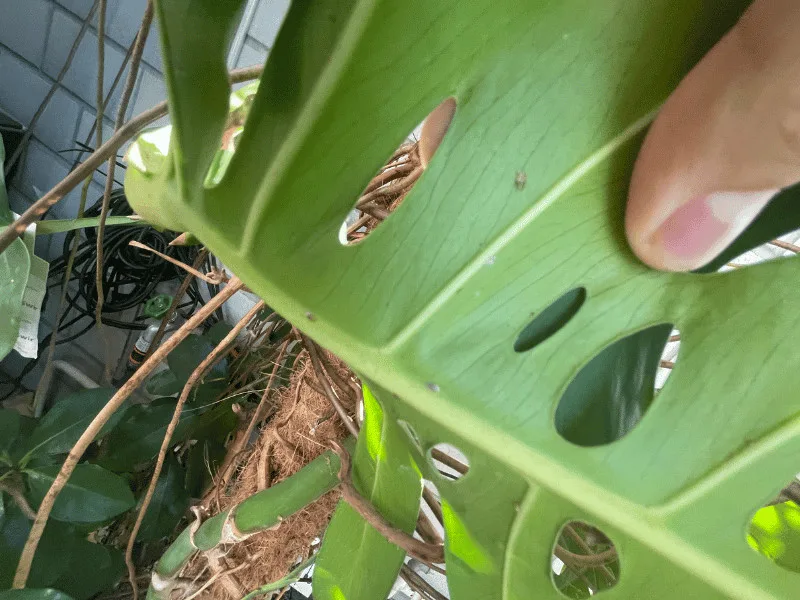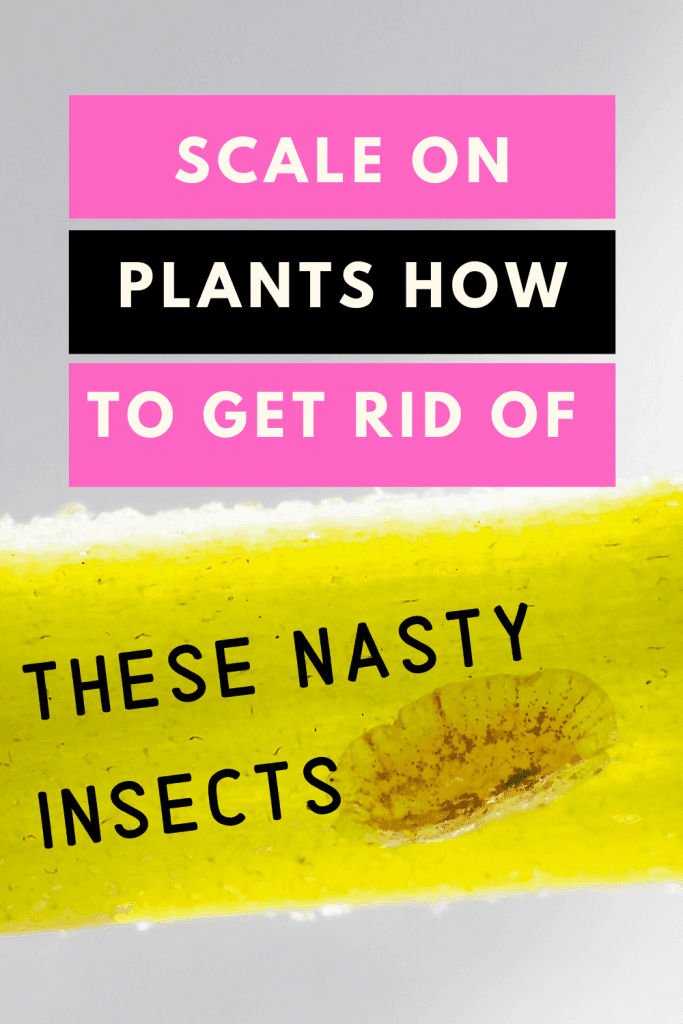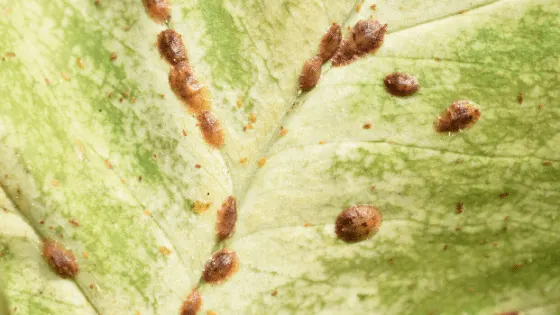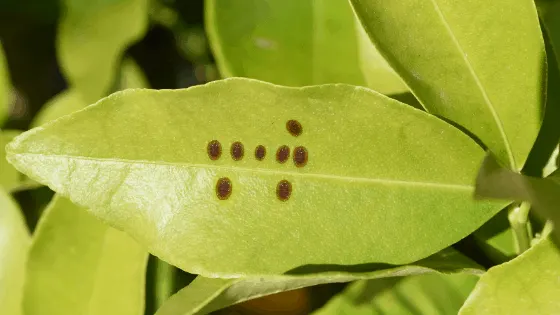Brown scale are very common on houseplants. You are reading this article because you suspect scale on your indoor plants. Here is what you need to know.
Brown Scale On Plants
Soft-scale bugs are so common on indoor and outdoor plants that you expect an infestation at least once. The brown scale ( Coccus hesperidum) is the most common scale. They’re also one of the ugliest pests. They resemble flat brown slugs embedding themselves into the leaves of a plant. It’s not a pretty sight at all.

Soft brown scale bugs aren’t easy to miss if they take over your plants. They are not easy to eliminate once you have an infestation.
Like most pests that infest indoor plants, brown scale feeds off the plant sap. When enough of these bugs feed off your plant, they’re sucking the life out of it.
So, how do you avoid brown scales? What should you do if brown scales infest and attack your plant?
Other plant pests are mealybugs and aphids.
Table of Contents

What are Brown Scales?
The brown-scale bug comes from the Coccidae family. Like the Pseudococcidae, these scale bugs don’t have protective armor. They grow to be between 0.01-0.2 inches (two and a half millimeters to five millimeters in length). The females are oval-shaped and wingless.
There are no identifiable body parts on these bugs. They also have long antennas that are almost impossible to see.
They can be yellow-brown or green-brown. But they’re usually a red-brown color. As they get older, they start to get darker and darker in color.
The brown scales have mouths that can pierce the plant to get to the sap. Their mouths also can suck the sap so they can ingest it. These mouths look like small straws if you are looking under a microscope.
Nymphs (or crawlers) produced by the females are oval too. They’re flat, and you can almost see through them. They’re so small they look like a speck to the naked eye.
Male brown scales are very, very rare. They’re usually smaller than their female counterparts. They have wings and long antennae.
The scales aren’t too picky on what plants they take over and feed from. But their favorite plants are citrus plants.
Scale Varieties
There are a few other soft-scale bugs that can take over indoor plants. Some of the most common include:
- Calico scale
- Cottony camellia scale
- Fern scale
- Lecanium scale/Fruit lecanium scale
- Magnolia scale
- Wax scale/Indian wax scale
How the Brown Scale Reproduces

A female brown scale creates about 250 eggs (or ovisacs) in their lifetime. In one year, they can produce several generations. This is unusual compared to soft-scale bugs that only produce one generation a year.
Brown Scale Lifecycle
According to the University of Illinois, the brown scale has several life cycles happening at once.
There will be grown adults producing nymphs. At the same time, there will be nymphs feeding on the plant in various stages.
Female brown scales reproduce through parthenogenesis. This means they reproduce without fertilization from a male scale.
The eggs stay inside the scale until they’ve hatched. Then, the female’s body releases the nymphs.
Once they’re released, the nymphs crawl away from their mother to find a place to feed. Hence the nickname “crawlers”.
The nymphs don’t get too far from their mother in the beginning.
They’ll stay in the same place to feed for the majority of their lives until they reach adulthood. This takes about a month.
If there is a male, he’ll go through the same growth stages. But once he reaches adulthood, he gets his wings.
How Brown Scale Attackes Your Plant
As most indoor plant pests do, brown scale feeds on the sap of a plant. However, these bugs feed on larger amounts of sap for their nutrients and hydration.
It provides them with everything they need to thrive and survive. It’s also what your plant needs to thrive and survive.
First, plants absorb nutrients from the soil. This is usually from the fertilizer you use on your plant. These nutrients are carried through the plant by its’ phloem sieve tube elements.
Next, the plants absorb water from their soil. Like the nutrients, indoor plants get their water from your care too. Xylem cells carry water through the plant. As they travel, the cells distribute the water to the rest of the plant.
So, when they feed off of your plant, they’re stealing your plant’s livelihood. It can’t go through photosynthesis. It will start to look ill because it is ill. In the worst cases, brown scales can kill your indoor plant.
On the bright side, it’s very rare for plants to die from these bugs. The infestation has to be pretty severe.

How to Prevent Brown Scale
The best way to prevent a scale infestation is to inspect every new plant you buy before bringing it into your home, especially if you have other plants. Scale spreads easily. If a plant is infested, quarantine it.
Whenever you can, you need to prevent a brown-scale infestation. Getting rid of any plant pest is frustrating. It also takes a lot of work and time.
Scale insects have become more of a problem due to climate change. The hotter an area is, the more stressed scales become. And the more stressed they become, the more eggs they produce.
So, only a few scales on your plant can turn to many more fast. The longer and hotter periods of heat kill the predators that take care of scales naturally.
One way to prevent brown scales is to water your plants, particularly during summer, sufficiently. It can be that simple to stop the critters from attacking it because a stressed plant is weak.
So, if a few scales find their way to your plant, they won’t be stressed from the heat. They won’t be popping out nymph after nymph after nymph.

How to Detect Brown Scale
So, what are the signs of a brown-scale infestation on your plant? There are a few things to look for to confirm your suspicions. When brown scales steal the sap from your plant, it will grow slowly. If your plant has a normal growth rate, you’ll notice the difference quickly.
The next sign you’ll notice is droopy, yellowing leaves. They might even curl from a lack of nutrients. There’s also a strong possibility that the leaves will drop off. Losing large amounts of sap weakens a plant, so it’s more likely to get injured by the smallest incidents.
As the pests feed, they excrete a sugary honeydew. Undigested sugar and water make up honeydew. This mix passes through a scale’s digestive system and onto a plant’s surface.
You can see honeydew residue on your plant. It’s a strange, clear, sticky substance found on the leaves and stems.
Another way to detect brown scales is when a black sooty mold starts growing on your plant. Honeydew left behind causes mold. The spores from this black mold can spread fast to other parts of your plant. The mold makes your plant sick and cuts down on the surfaces for it to go through photosynthesis.
How to Identify Brown Scale
Brown scale looks like strange brown bumps on your leaves. They can be on top of a leaf or underneath a leaf.
If your plant has one or more symptoms, you should try to get a visual confirmation. Since they’re so small, this can be hard to do regarding brown scales.
You’ll also find them on the stem of your plant feeding. You can find them even feeding on branches if your plant has branches.
How to Get Rid of a Small Brown Scale Infestations
Caring for the problem isn’t quite as hard when you catch a brown-scale infestation early.
1. Remove by hand
Your first option for removing a small infestation is to pick them off individually. You can also rub them off of the leaves. You need a strong stomach to do it this way. They’re very creepy-looking creatures, even for bugs.
2. Use Alcohol Diluted in Water
Another method is to use ethanol alcohol. You can use 70% isopropyl alcohol, too.
Since brown scales can be difficult to eliminate, we prefer stronger alcohol.
But you should test a small area of your plant before using alcohol. It’s strong, and some plants can’t take it. Let the plant sit for a day and see how it did.
If it’s too strong, use the isopropyl alcohol instead. Again, you’ll still want to test a small area to ensure your plant doesn’t react badly.
You can always dilute the isopropyl alcohol if you’re worried about any damage to your plant. You’ll need either a cotton swab or a cotton ball for this method. You’ll dab an end of the cotton swab with the alcohol. Or dab the cotton ball with it.
You’re going to dab all the infested areas with the alcohol. This should kill the brown scales.
2. Use Neem Oil Against Scale
Neem oil is also a fantastic way to get rid of small brown-scale infestations. It’s all-natural. Plus, it doesn’t leave gross residue behind on your plant when you use it.
You can also use neem oil on large infestations, but when it comes to scales, it can be not easy. Neem oil comes from the neem tree. These trees are found in Bangladesh, India, Pakistan, and Sri Lanka.
Sometimes, companies advertise neem oil as leaf shine. You mix neem oil with water in a spray bottle. Then, you can spray your plant. Make sure you spray every little bit of the plant you’re treating.
When you spray the neem oil, it hits the brown scales, feeding off the plant. Since it’s oil, it’s heavy. It clogs the scales’ pores, suffocating them. Once they’re dead, they’re easy to sweep or rub off the plant.
Dead brown scales are hollow. That soft, waxy coat sometimes even rubs off when you try to grab them.
If you rub a living scale, a sticky residue will be left on your hand or fingers.
You’ll have to repeat this method at least once a week for two or three weeks to ensure you get every bug.
How to Get Rid of Large Brown-Scale Infestations
To get rid of large brown-scale infestations on plants, two effective methods are horticulture oils and insecticidal soap.
Horticulture oils suffocate the scales by blocking their breathing openings or affecting their feeding. These oils should be diluted with water and sprayed on the plants at temperatures between 45°F and 70°F (7.2°C to 21.1°C).
The treatment should be repeated weekly for 2-3 weeks. Insecticidal soap, made from fatty acids, also suffocates the scales and removes their waxy covering.
Before using, test the soap on a small area of the plant and wait 24 hours to check for any adverse reactions. Dilute one tablespoon of soap per quart of water and spray the plant thoroughly, especially under the leaves. Repeat the process every four days.
Both treatments are generally safe for plants and won’t leave a residue.
DIY Insecticide against Brown Scale
The most effective method of ridding your plant of brown scale is a mix you can make at home.
You’ll need:
- Mild dish detergent
- Water
- Spray bottle
You’re going to mix the mild dish detergent with water. Try not to use hard water when you’re making this mixture.
Mix in three teaspoons of dish detergent for every gallon of water you use. Once you mix the dish detergent and water in a spray bottle, you can spray your plant down.
It slows down the brown scales and suffocates them. You’ll have to wipe down the plant later so the detergent isn’t sitting on it too long. Sometimes, you must turn to chemical pesticides since brown scales are difficult.
It should always be a last resort because chemical pesticides can harm your plant. Make sure whatever pesticides you use are made for indoor plants. You might have to discard the plant when an infestation is too bad.
FAQ
Why do I have both brown-scale bugs and ants?
The honeydew that brown scales excrete after feeding doesn’t only create mold. Its sweetness attracts ants. They stick around once they realize they have a steady flow of honeydew.
What does “soft” brown scale mean?
There are soft scales and armored scales. Armored scales have an armor-like shell over their bodies. When the pest is a soft scale, it doesn’t have that armor to protect it, but instead, it has a thin waxy layer.
Why isn’t the insecticidal soap killing the brown scales on my plant?
One of the most common reasons is the water you use when mixing the soap. You don’t want to use hard water. Hard water contains calcium and magnesium, which breaks apart the fatty acids.
Conclusion
Soft brown scale are nasty pests. It’s important to get rid of them before the infestation grows. It’s a process of treating your plants for brown scales. But with some hard work, you’ll get rid of these bugs quickly.

Daniel has been a plant enthusiast for over 20 years. He owns hundreds of houseplants and prepares for the chili growing seasons yearly with great anticipation. His favorite plants are plant species in the Araceae family, such as Monstera, Philodendron, and Anthurium. He also loves gardening and is growing hot peppers, tomatoes, and many more vegetables.


